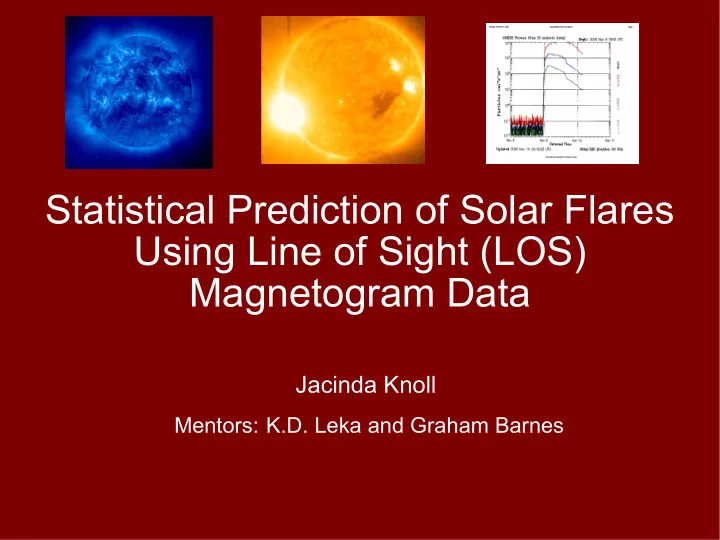

Statistical Prediction of Solar Flares Using Line of Sight (LOS) Magnetogram Data Jacinda Knoll Mentors: K.D. Leka and Graham Barnes
Outline Importance of Solar Flare Prediction Data and Method Used Special Considerations Data Preparation Results Summary Areas for Further Research 31 July 2008 REU LASP 2008 2 NWRA/CoRA
Importance of Solar Flare Prediction Cannot “Now-Cast” as effects travel at speed of light − Cause damage at same time as detection Satellite disruption Astronaut Safety X-Ray radiation alters ionosphere − Loss of communication Especially in short-wave bands Flight over the North Pole 31 July 2008 REU LASP 2008 3 NWRA/CoRA
Data and Process Data Being Used − MDI Line of Sight (LOS) Magnetogram Data − Observations from 1996-2004 − 204 x 204 pixel images centered on every active region observed Statistical Technique − Discriminant Analysis Same technique being used for the IVM data 31 July 2008 REU LASP 2008 4 NWRA/CoRA
Special Considerations: LOS Data Advantages − Nearly 20,000 raw data points, with between 6,000 and 10,000 points with good data − Large sample sizes needed for statistics (especially non-parametric) Disadvantages − Cannot calculate many of the parameters available for vector magnetogram data (e.g. J z , H c , ψ NL ) − Data further from disc center less reliable due to observing angle correction factor 31 July 2008 REU LASP 2008 5 NWRA/CoRA
Example Fairly good data... ...gets worse and worse.
Data-Checking Data had to be pared down before analysis − Removal of bad instrument data 11586 good points out of 19295 total points: 60% of data − Created IDL keywords to specify different limits to place on the data Distance from disk center to throw out magnetogram Distance from disk center to zero out data − Allows greater control over the analysis 31 July 2008 REU LASP 2008 7 NWRA/CoRA
Results Predictive Power of DA varies year to year - Why? Quantification of Unreliability Further from Disk Center - Decrease of nearly 200% from Disk Center to 45 degrees out Potential Field Correction Does Not Improve Results - Although it is an improvement on observing angle correction 31 July 2008 REU LASP 2008 8 NWRA/CoRA
Variation with Year One Hypothesis - More magnetograms give better results - Weak trend to support this as more data seems to give a higher skill score Not the only possible explanation 31 July 2008 REU LASP 2008 9 NWRA/CoRA
Variation with Year First hypothesis called into question by “All Data” anomaly Weak possible trend not supported Alternative Explanation - Predictive power somehow tied to solar cycle - Need more data to confirm 31 July 2008 REU LASP 2008 10 NWRA/CoRA
Decrease in Skill Score with Distance from Disk Center 31 July 2008 REU LASP 2008 11 NWRA/CoRA
Differences in Data Includes data within 60° of disk center Includes data within 45° of disk center 31 July 2008 REU LASP 2008 12 NWRA/CoRA
Who Cares? Researchers want large datasets − Often try to stretch the limits with LOS data Many say up to 60 degrees is acceptable using observing angle correction − Definitely not the case − Even 45 degrees is questionable 31 July 2008 REU LASP 2008 13 NWRA/CoRA
Potential Field Correction “Mu Correction” not an accurate measure of magnetic field on the sun Potential field correction method models active regions as potential fields instead of assuming all magnetic field is perpendicular Approximation produced similar results to the mu correction 31 July 2008 REU LASP 2008 14 NWRA/CoRA
Mu Correction vs. Potential Field In some cases, mu does better, in some cases, potential field does better (black crosses are mu, blue stars are PF) 31 July 2008 REU LASP 2008 15 NWRA/CoRA
Not the Final Word Consistently greater difference between the potential field correction and observing angle correction further from disk center
Comparison with Peer Parameters R Parameter posited by Schrijver in 2007 paper − Locations of strong opposite-polarity magnetic fields adjacent to each other − Declared as proxy for photospheric electrical currents Uses Data Set from 1999 – 2006 Implemented in Code, but still working out bugs − Unable to compare results 31 July 2008 REU LASP 2008 17 NWRA/CoRA
Summary of my Summer Analysis Code Edited to Allow User to Choose Data Limits Discovered annual variations in predictive power Quantitatively confirmed unreliability of data far from disk center Investigated difference between observing angle correction and potential field correction 31 July 2008 REU LASP 2008 18 NWRA/CoRA
Future Research Possibilities Add more data to flush out reason behind annual variations See how far potential field correction can be extended beyond observing angle correction Fix code for Schrijver's R parameter and investigate differences in results Compare four-year results for similar parameters with IVM data Analyze differences in results between parametric and non-parametric DA − LOS ideal for NPDA because of large dataset 31 July 2008 REU LASP 2008 19 NWRA/CoRA
Recommend
More recommend